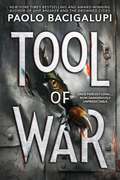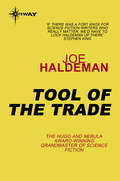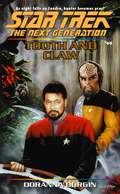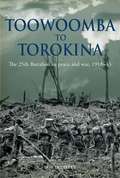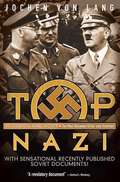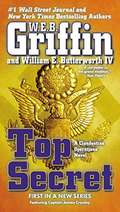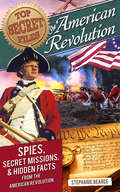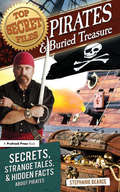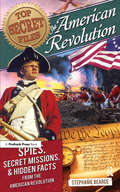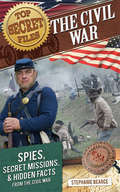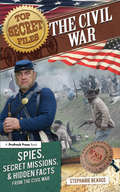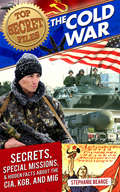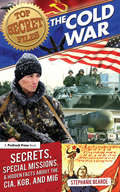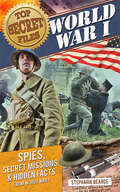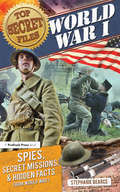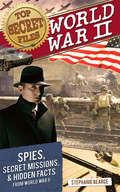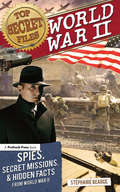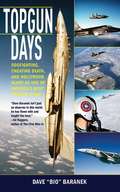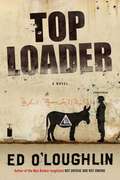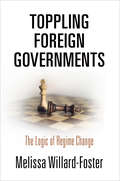- Table View
- List View
Tool of War (Ship Breaker)
by Paolo BacigalupiThis third book in a major series by a bestselling science fiction author, Printz Award winner, and National Book Award finalist is the gripping story of the most provocative character from his acclaimed novels Ship Breaker and The Drowned Cities.Tool, a half-man/half-beast designed for combat, is capable of so much more than his creators had ever dreamed. He has gone rogue from his pack of bioengineered "augments" and emerged a victorious leader of a pack of human soldier boys. But he is hunted relentlessly by someone determined to destroy him, who knows an alarming secret: Tool has found the way to resist his genetically ingrained impulses of submission and loyalty toward his masters... The time is coming when Tool will embark on an all-out war against those who have enslaved him. From one of science fiction's undisputed masters comes a riveting page-turner that pulls no punches."Suzanne Collins may have put dystopian literature on the YA map with 'The Hunger Games'...but Bacigalupi is one of the genre's masters, employing inventively terrifying details in equally imaginative story lines." --Los Angeles Times
Tool of the Trade
by Joe HaldemanNick Foley is on the run. The KGB and CIA are both after him. Not suprising, since he's a Soviet sleeper whose cover has been blown, but Nick has more than state secrets to hide. If he tells a stranger to drive him a thousand miles, it'll happen; if he tells a pusher to OD on his own heroin, the pusher will do it.Nick's strange power is vital to both sides, and neither of them intend to let him keep it to himself, but neither the CIA nor the KGB can imagine Nick's final, desperate throw of the dice.
Tooth and Claw: Star Trek The Next Generation: Tng#60 (Star Trek: The Next Generation #60)
by Doranna DurginNtignano was a populated world with a perfect sun -- until the right technology fell into the wrong hands. Now the sun is failing quickly, and the Starship Enterprise has just one chance to evacuate the þeeing refugees. Captain Jean-Luc Picard must succeed in delicate negotiations with the only people who can help them: a prickly neighboring species known as the Tsorans. To assist in that effort, Commander Will Riker was assigned a very different diplomatic task. As a polite formality and show of good faith, he accompanied a young Tsoran prince to an exclusive hunting preserve. There, technology-damping Þelds and some of the galaxy's deadliest predators were supposed to test the untried noble's ability in the kaphoora -- the hunt. But the shuttlecraft didn't land on Fandre; it crashed. Now, cut off from Tsora and the Enterprise, the survivors of the disaster face the ultimate struggle for survival. Without the aid of tricorders or phasers, Riker, his royal charge, and their would-be rescuers must Þght for their lives with the only weapons they can muster -- spears and bat'leth, tooth and claw.
Tooth and Nail
by Craig Dilouie"This is the way the world ends. Not with a bang, not with a whimper, but a slaughter.
Toowoomba to Torokina: The 25th Battalion in peace and war, 1918-1945
by Bob DoneleyToowoomba to Torokina traces the proud history of the 25th Battalion from the end of one war to end of the next. It tells the story of the men from Toowoomba and the Darling Downs who answered the call to fight a war that would threaten their country's very existence. Like their First World War predecessors, they fought a determined foe in hellish conditions with, as the Battalion's motto decrees, `Never a Backwards Step'.
Top Dog
by Maria GoodavageThe New York Times bestselling author of Soldier Dogs returns with the incredible story of K-9 Marine hero Lucca, and the handlers who fought alongside her through two bloody wars in Iraq and Afghanistan. In Top Dog, Maria Goodavage takes readers into the life of Lucca K458, a decorated and highly skilled military working dog. An extraordinary bond develops between Lucca and Marine Corps dog handlers Chris Willingham and Juan Rodriguez, in what would become a legendary 400-mission career. A Specialized Search Dog, Lucca belongs to an elite group trained to work off-leash at long distances from her handler. She served alongside both Special Forces and regular infantry, and became so sought-after that platoons frequently requested her by name. The book describes in gritty detail Lucca's adventures on and off the battlefields, including tense, lifesaving explosives finds and firefights, as well as the bravery of fellow handlers and dogs they served with. Ultimately we see how the bond between Lucca and her handlers overcame the endless brutalities of war and the traumas this violence ignites. Here is a portrait of modern warfare with a heartwarming and inspiring conclusion that will touch dog lovers and the toughest military readers.
Top Nazi
by Jochen Von LangDeeply involved in the Holocaust as Heinrich Himmler's deputy for administration, Karl Wolff personally arranged for the transportation of 300,000 Jews from Poland to the Treblinka death camp in 1943. He went to trial in Germany and received a short prison sentence in 1964. But Wolff, even more than Reinhard Heydrich, could claim to enjoy Adolf Hitler's complete confidence. He was appointed SS police chief in northern Italy in 1943-1945 and ordered by the Führer himself to kidnap the Pope and the cardinals and take them to Germany. Wolff managed to talk Hitler out of the wild scheme and escaped hanging at Nuremberg by negotiating the surrender of the German armies in Italy with Allen Dulles in Switzerland.
Top Secret (Clandestine Operations #1)
by William E. Butterworth W.E.B. GriffinFrom the #1 New York Times-bestselling author, a brand-new series about the Cold War--and a different breed of warrior. In the first weeks after World War II, a squeaky-clean new second lieutenant named James D. Cronley Jr. is spotted and recruited for a new enterprise that will eventually be transformed into something called the CIA. One war may have ended, but another one has already begun, against an enemy that is bigger, smarter, and more vicious: the Soviet Union. The Soviets have hit the ground running, and Cronley's job is to help frustrate them, harass them, and spy on them any way he can. His recruiter thinks he has the potential to become an asset--though, of course, he could also screw up spectacularly. And in his first assignment, it looks like that's exactly what might happen. He's got seven days to extract a vital piece of information from a Soviet agent, but Cronley's managed to rile up his superior officers (he seems to have a talent for it), and if he fails, it could be one of the shortest intelligence careers in history. There are enemies everywhere--and, as Cronley is about to find out, some of them even wear the same uniform he does.
Top Secret Alien Abduction Files: What the Government Doesn't Want You to Know
by Nick RedfernWhy and how the government monitors those who have been kidnapped by strange, unearthly beings with even stranger agendas, from the author of Final Events.For decades, people have reported close encounters with extraterrestrial entities. Witnesses describe being kidnapped by large-headed, black-eyed creatures from other worlds. Those same creatures have become popularly known as “the Grays.” There is, however, another aspect to the alien abduction controversy.Abductees very often report being followed and spied upon by military and government personnel. It is typical for abductees to see black helicopters hovering directly over their homes in an intimidating manner. Phone calls are monitored. Emails are hacked into. Strange men dressed in black suits are seen photographing the homes of the abductees. All of this brings us to the matter of what have become known in the domain of alien abduction research as “Military Abductions,” or “MILABS.”According to numerous abductees, after being kidnapped by aliens they are kidnapped again . . . by the government. These follow-up events are the work of a powerful group hidden deep within the military and the intelligence community. It is the secret agenda of this highly classified organization to figure out what the so-called Grays are really up to. And, the best way for the government to get the answers is to interrogate those who have come face-to-face with the UFO phenomenon: the abductees. Why is the government secretly compiling files on alien abductees? Is the alien abduction issue so sinister that it has become a matter of national security proportions?
Top Secret Files: American Revolution
by Stephanie BearceGeorge Washington had his own secret agents, hired pirates to fight the British, and helped Congress smuggle weapons, but you won't learn that in your history books! Learn the true stories of the American Revolution and how spies used musket balls, books, and laundry to send messages. Discover the female Paul Revere, solve a spy puzzle, and make your own disappearing ink. It's all part of the true stories from the Top Secret Files of History. Take a look if you dare, but be careful! Some secrets are meant to stay hidden...
Top Secret Files: Pirates and Buried Treasure, Secrets, Strange Tales, and Hidden Facts About Pirates (Top Secret Files Of History Ser. #0)
by Stephanie BearcePirates of the Golden Age had to deal with scurvy, fight ferocious battles, and eat everything from monkeys to snakes to sea turtles, but you won't learn that in your history books! Discover the truth about Anne Bonny, the Irish woman who was a true Pirate of the Caribbean, and the secrets of Blackbeard and the daring pirate Cheng I Sao. Then learn how to talk like a pirate and make a buried treasure map for your friends. It's all part of the true stories from the Top Secret Files: Pirates and Buried Treasure. Take a look if you dare, but be careful! Some secrets are meant to stay hidden . . . Ages 9-12
Top Secret Files: The American Revolution, Spies, Secret Missions, and Hidden Facts From the American Revolution
by Stephanie BearceGeorge Washington had his own secret agents, hired pirates to fight the British, and helped Congress smuggle weapons, but you won't learn that in your history books! Learn the true stories of the American Revolution and how spies used musket balls, books, and laundry to send messages. Discover the female Paul Revere, solve a spy puzzle, and make your own disappearing ink. It's all part of the true stories from the Top Secret Files: The American Revolution. Take a look if you dare, but be careful! Some secrets are meant to stay hidden . . . Ages 9-12
Top Secret Files: The Civil War
by Stephanie BearceThe pigpen cipher, the Devil's Coffee Mill, and germ warfare were all a part of the Civil War, but you won't learn that in your history books! Discover the truth about Widow Greenhow's spy ring, how soldiers stole a locomotive, and the identity of the mysterious "Gray Ghost." Then learn how to make a cipher wheel and send secret light signals to your friends. It's all part of the true stories from the Top Secret Files: The Civil War. Take a look if you dare, but be careful! Some secrets are meant to stay hidden...
Top Secret Files: The Civil War, Spies, Secret Missions, and Hidden Facts From the Civil War
by Stephanie BearceThe pigpen cipher, the Devil's Coffee Mill, and germ warfare were all a part of the Civil War, but you won't learn that in your history books! Discover the truth about Widow Greenhow's spy ring, how soldiers stole a locomotive, and the identity of the mysterious “Gray Ghost.” Then learn how to make a cipher wheel and send secret light signals to your friends. It's all part of the true stories from the Top Secret Files: The Civil War. Take a look if you dare, but be careful! Some secrets are meant to stay hidden . . . Ages 9-12
Top Secret Files: The Cold War
by Stephanie BearcePoison dart umbrellas, lipstick pistols, and cyanide guns were all a part of the arsenal of tools used by spies of the Soviet KGB, American CIA, and British MI6, but you won't learn that in your history books! Learn the true stories of the Cold War and how spies used listening devices planted in live cats and wristwatch cameras. Discover how East Germans tried to ride zip lines to freedom, while the Cambridge Four infiltrated Britain and master spy catchers like Charles Elwell were celebrated. Then make your own secret codes and practice sending shoe messages. It's all part of the true stories from the Top Secret Files: The Cold War. Take a look if you dare, but be careful! Some secrets are meant to stay hidden...
Top Secret Files: The Cold War, Secrets, Special Missions, and Hidden Facts About the CIA, KGB, and MI6 (Top Secret Files Of History Ser. #0)
by Stephanie BearcePoison dart umbrellas and cyanide guns were all a part of the arsenal of tools used by spies of the Soviet KGB, American CIA, and British MI6, but you won't learn that in your history books! Learn the true stories of the Cold War and how spies used listening devices planted in live cats and wristwatch cameras. Discover how East Germans tried to ride zip lines to freedom, while the Cambridge Four infiltrated Britain and rockets raced to the moon. Then make your own submarines and practice writing secret codes. It's all part of the true stories from the Top Secret Files: The Cold War. Take a look if you dare, but be careful! Some secrets are meant to stay hidden . . .Ages 9-12
Top Secret Files: World War I
by Stephanie BearceFlame throwers, spy trees, bird bombs, and Hell Fighters were all a part of World War I, but you won't learn that in your history books! Uncover long-lost secrets of spies like Howard Burnham, "The One Legged Wonder," and nurse-turned-spy, Edith Cavell. Peek into secret files to learn the truth about the Red Baron and the mysterious Mata Hari. Then build your own Zeppelin balloon and mix up some invisible ink. It's all part of the true stories from the Top Secret Files of History. Take a look if you dare, but be careful! Some secrets are meant to stay hidden...
Top Secret Files: World War I, Spies, Secret Missions, and Hidden Facts from World War I (Top Secret Files Of History Ser. #0)
by Stephanie BearceFlame throwers, spy trees, bird bombs, and Hell Fighters were all a part of World War I, but you won't learn that in your history books! Uncover long-lost secrets of spies like Howard Burnham, “The One-Legged Wonder,” and nurse-turned-spy, Edith Cavell. Peek into secret files to learn the truth about the Red Baron and the mysterious Mata Hari. Then learn how to build your own Zeppelin balloon and mix up some invisible ink. It's all part of the true stories from the Top Secret Files: World War I. Take a look if you dare, but be careful! Some secrets are meant to stay hidden . . . Ages 9-12
Top Secret Files: World War II (Top Secret Files of History)
by Stephanie BearceSpy school, poison pens, exploding muffins, and Night Witches were all a part of World War II, but you won't learn that in your history books! Crack open secret files and read about the mysterious Ghost Army, rat bombs, and doodle bugs. Discover famous spies like the White Mouse, super-agent Garbo, and baseball player and spy, Moe Berg. Then build your own secret agent kit and create a spy code. It's all part of the true stories from the Top Secret Files of History. Take a look if you dare, but be careful! Some secrets are meant to stay hidden...
Top Secret Files: World War II, Spies, Secret Missions, and Hidden Facts From World War II
by Stephanie BearceSpy school, poison pens, exploding muffins, and Night Witches were all a part of World War II, but you won't learn that in your history books! Crack open secret files and read about the mysterious Ghost Army, rat bombs, and doodlebugs. Discover famous spies like the White Mouse, super-agent Garbo, and baseball player and spy, Moe Berg. Then build your own fingerprint kit and crack a spy code. It's all part of the true stories from the Top Secret Files: World War II. Take a look if you dare, but be careful! Some secrets are meant to stay hidden . . . Ages 9-12
Topgun Days: Dogfighting, Cheating Death, and Hollywood Glory as One of America's Best Fighter Jocks
by Dave BaranekDave Baranek (callsign "Bio") was one of 451 young men to receive his Wings of Gold in 1980 as a naval flight officer. <P><P>Four years later, seasoned by intense training and deployments in the tense confrontations of the cold war, he became the only one of that initial group to rise to become an instructor at the navy's elite Fighter Weapons School. As a Topgun instructor, Bio was responsible for teaching the navy's and Marine Corps's best fighter pilots how to be even better. He schooled them in the classroom and then went head-to-head with them in the skies. Then, in August 1985, Bio was assigned to combine his day-to-day flight duties with participation in a Pentagon-blessed project to film action footage for a major Hollywood movie focusing on the lives, loves, heartbreaks, and triumphs of young fighter pilots: Top Gun. Bio soon found himself riding in limousines to attend gala premieres, and being singled out by giggling teenagers and awed schoolboys who recognized the name "Topgun" on his T-shirts. The book ends with his reflections on his career as a skilled naval aviator and his enduring love of flight.
Topgun Days: Dogfighting, Cheating Death, and Hollywood Glory as One of America's Best Fighter Jocks
by Dave BaranekDave Baranek (callsign "Bio") was one of 451 young men to receive his Wings of Gold in 1980 as a naval flight officer. Four years later, seasoned by intense training and deployments in the tense confrontations of the cold war, he became the only one of that initial group to rise to become an instructor at the navy's elite Fighter Weapons School. As a Topgun instructor, Bio was responsible for teaching the best fighter pilots of the Navy and Marine Corps how to be even better. He schooled them in the classroom and then went head-to-head with them in the skies.Then, in August 1985, Bio was assigned to combine his day-to-day flight duties with participation in a Pentagon-blessed project to film action footage for a major Hollywood movie focusing on the lives, loves, heartbreaks, and triumphs of young fighter pilots: Top Gun.Bio soon found himself riding in limousines to attend gala premieres, and being singled out by giggling teenagers and awed schoolboys who recognized the name "Topgun" on his T-shirts. The book ends with his reflections on his career as a skilled naval aviator and his enduring love of flight. The paperback and Kindle editions include more than fifty rare full color photographs of fighter jets in action.
Topgun: An American Story
by Dan PedersenOn the 50th anniversary of the creation of the "Topgun" Navy Fighter School, its founder shares the remarkable inside story of how he and eight other risk-takers revolutionized the art of aerial combat. When American fighter jets were being downed at an unprecedented rate during the Vietnam War, the U.S. Navy turned to a young lieutenant commander, Dan Pedersen, to figure out a way to reverse their dark fortune. On a shoestring budget and with little support, Pedersen picked eight of the finest pilots to help train a new generation to bend jets like the F-4 Phantom to their will and learn how to dogfight all over again. What resulted was nothing short of a revolution -- one that took young American pilots from the crucible of combat training in the California desert to the blistering skies of Vietnam, in the process raising America's Navy combat kill ratio from two enemy planes downed for every American plane lost to more than 22 to 1. Topgun emerged not only as an icon of America's military dominance immortalized by Hollywood but as a vital institution that would shape the nation's military strategy for generations to come. Pedersen takes readers on a colorful and thrilling ride-from Miramar to Area 51 to the decks of aircraft carriers in war and peace-through a historic moment in air warfare. He helped establish a legacy that was built by him and his "Original Eight" -- the best of the best -- and carried on for six decades by some of America's greatest leaders. Topgun is a heartfelt and personal testimonial to patriotism, sacrifice, and American innovation and daring.
Toploader
by Ed O'LoughlinIn a novel compared by some reviewers to Catch-22 for its mix of humor and outrage, this brilliant send-up of modern military adventurism is an insightful and darkly comic anti-war masterpiece. Its setting is the Embargoed Zone (or "Easy"), headquarters to the coalition of western allies, somewhere in the Middle East.Spying inside the Easy is expensive and hazardous, and the "terrorist" double agent known as Cobra needs his wages paid in cash in order to survive. But his down-at-heels spymaster from the occupying forces, one Captain Smith, is broke and forced to pay his agent in kind--with a top-loading washing machine pilfered from the American compound. When it turns out that this piece of clothes-washing technology is in fact a critical piece of military hardware essential to the allied war effort, a frantic scramble to retrieve the device is unleashed.Packed with unforgettable characters--including a resourceful teenage girl from the occupied territory, an intrepid local reporter navigating the Easy in search of the truth, an egotistical western blogger with delusions of relevance, a hapless drone pilot with an itchy trigger finger, and at least one very unfortunate donkey--Toploader is a savage and hilarious indictment of remote-control warfare and imperialism by proxy.
Toppling Foreign Governments: The Logic of Regime Change
by Melissa Willard-FosterIn 2011, the United States launched its third regime-change attempt in a decade. Like earlier targets, Libya's Muammar Qaddafi had little hope of defeating the forces stacked against him. He seemed to recognize this when calling for a cease-fire just after the intervention began. But by then, the United States had determined it was better to oust him than negotiate and thus backed his opposition. The history of foreign-imposed regime change is replete with leaders like Qaddafi, overthrown after wars they seemed unlikely to win. From the British ouster of Afghanistan's Sher Ali in 1878 to the Soviet overthrow of Hungary's Imre Nagy in 1956, regime change has been imposed on the weak and the friendless.In Toppling Foreign Governments, Melissa Willard-Foster explores the question of why stronger nations overthrow governments when they could attain their aims at the bargaining table. She identifies a central cause—the targeted leader's domestic political vulnerability—that not only gives the leader motive to resist a stronger nation's demands, making a bargain more difficult to attain, but also gives the stronger nation reason to believe that regime change will be comparatively cheap. As long as the targeted leader's domestic opposition is willing to collaborate with the foreign power, the latter is likely to conclude that ousting the leader is more cost effective than negotiating.Willard-Foster analyzes 133 instances of regime change, ranging from covert operations to major military invasions, and spanning over two hundred years. She also conducts three in-depth case studies that support her contention that domestically and militarily weak leaders appear more costly to coerce than overthrow and, as long as they remain ubiquitous, foreign-imposed regime change is likely to endure.
